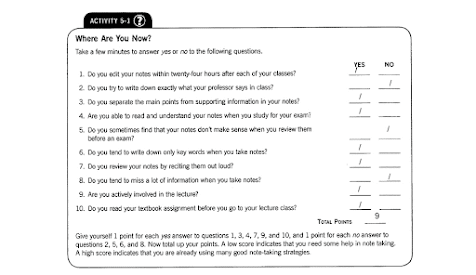Topic 5 : Taking lecture note
5.1 Note-taking strategies
How to take notes ?
1. write concise notes
2. record lectures on a voicenote
3. pay close attention
4. highlight and underlines your note
5. get rids of distraction
6. share our lecture notes to friends
5.2 Note-taking using the Cornell Method
The Cornell Note Taking method discourages the use of long sentences. It is about short notes that you write down in the right-hand column using recognizable abbreviations and symbols. Prior to the note taking, draw up a list of abbreviations and expressions. This makes the note-taking process even easier.
EXAMPLE :
ADDITIONAL TIPS ON HOW TO WRITE NOTES
Don’t rely on your memory alone. Many stu-
dents think they should be able to remember the
information presented in a lecture if they pay
careful attention. Unfortunately, we tend to forget
rapidly. With four to seven weeks between exams,
taking notes is critical.
❏ Use a full-size notebook. Use a separate
81⁄2-by-11-inch notebook for each of your classes.
Using smaller notebooks can unconsciously lead
to writing fewer notes.
❏ Include the topic in your notes. By including
the topic, you’re helping to organize your mind
for listening and your notes for later review.
❏ Leave some space in your notes. By leav-
ing a 21⁄2- to 31⁄2-inch margin on the left side of
the page, you’ll be able to add recall questions
when you edit your notes. Also, leave a blank
line or two before you write each of your head-
ings in case the professor adds information
later in the lecture.
❏ Use common abbreviations in your notes. By
using some familiar abbreviations, you can get the
information down more quickly. Don’t use too
many abbreviations, though, or you won’t know
what they mean. See the list of common abbrevia-
tions on the Web site.
❏ Skip a few spaces if you miss
information. Skip a line or two and go on to the
next point. If you miss a keyword, draw a line .




No comments:
Post a Comment